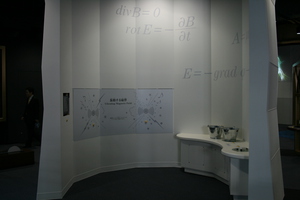Nagoya City Science Museum
TOP > Exhibition Guide > Keyword Search > Starting with "M" > magnetic field > Vibrating Magnetic Field
Vibrating Magnetic Field



Purpose of Exhibition
You will learn that electric currents give power to magnets through listening for sounds and looking at magnets vibrating.
Additional Knowledge
In the exhibit, if you place the bottom of a bucket against a wall, you can hear music from the bucket. It is strange that you can hear music from the bucket. But the bucket plays the same role as a speaker by utilizing a relationship between electricity and magnets.
At the bottom of the bucket, magnets are attached. They are quite powerful neodymium magnets. Behind the wall, electric lines are set and electric currents are flowing. When you place the bucket on the wall, the distance between the electric current and the magnet gets closer and the magnets start moving, receiving power from the electric current. If the electric current comes from the music player, depending on how loud or quiet the sound is, the motion of the magnet goes fast or slow. The magnet also shakes the bottom of the bucket and the vibration becomes music. That is how sounds are heard. The electric lines behind the wall are coiled so that a powerful magnetic field can be generated even with slight electric currents. Coils consist of many electric lines bound together.
[Mechanism of Speakers]
A speaker is a typical device that produces sounds with electric currents. You can find speakers everywhere such as in TVs, radios, and school classrooms. The bucket and the speaker in the exhibit generate sounds with the same principle, but they operate on different mechanisms. The bucket in the exhibit generates sounds by magnetic vibration while a speaker produces sounds with the vibration of a coil. Generally, a speaker produces sounds by getting coils to vibrate. A coil is attached to a trembler called cone paper and sounds are given off by making the coil operate with a fixed magnet. It is more efficient to actuate a light coil than a heavy magnet like the bucket in the exhibition.
[Speakers and Microphones]
In this exhibit, you can experience the power produced when electric currents work for a magnet as a sound. But there is also a case in which the magnet affects the coil. When moving the magnet near the coil, electric currents are created inside the coil. Singing toward the bucket in the exhibit, electric currents will be produced in the coil behind the wall. Amplifying the electric current and connecting it with other speaker, the song you have just sung will be heard loudly. The bucket has been turned into a microphone. If two speakers are connected with electric lines and talk to the other speaker, it is easy to demonstrate that sounds will be given off from the other speaker.
[Motors]
Motors are a good and familiar example that uses electric currents and magnets. When a motor is electrified, it spins. It also uses the power produced between electric currents and magnets. In the same way a speaker is turned into a microphone, a motor becomes a generator. If the axis of the motor is rotated forcibly, electric current is generated. As conducted in the speaker, it is easy to demonstrate that if you connect two motors with electric lines and spin one side with your hand, the other side rotates.
[Discovery of Magnetic Action of Electric Currents]
Electric currents move a magnet. That is due to "Magnetic Action of Electric Currents", which indicates the motion of a compass placed near an electrified wire. A Danish physicist, Oersted, discovered the action in 1820. From that point onward, electromagnetism was developed rapidly, such as the relationship between magnetic fields, developed with electric currents. An electromagnet that becomes a magnet when conducting wire is wound to an iron and electric current applied was invented. The currents were mathematized and electromagnetic induction was discovered: generating electric currents by moving a magnet.
Article by Yoshitaka Yamada, curator
